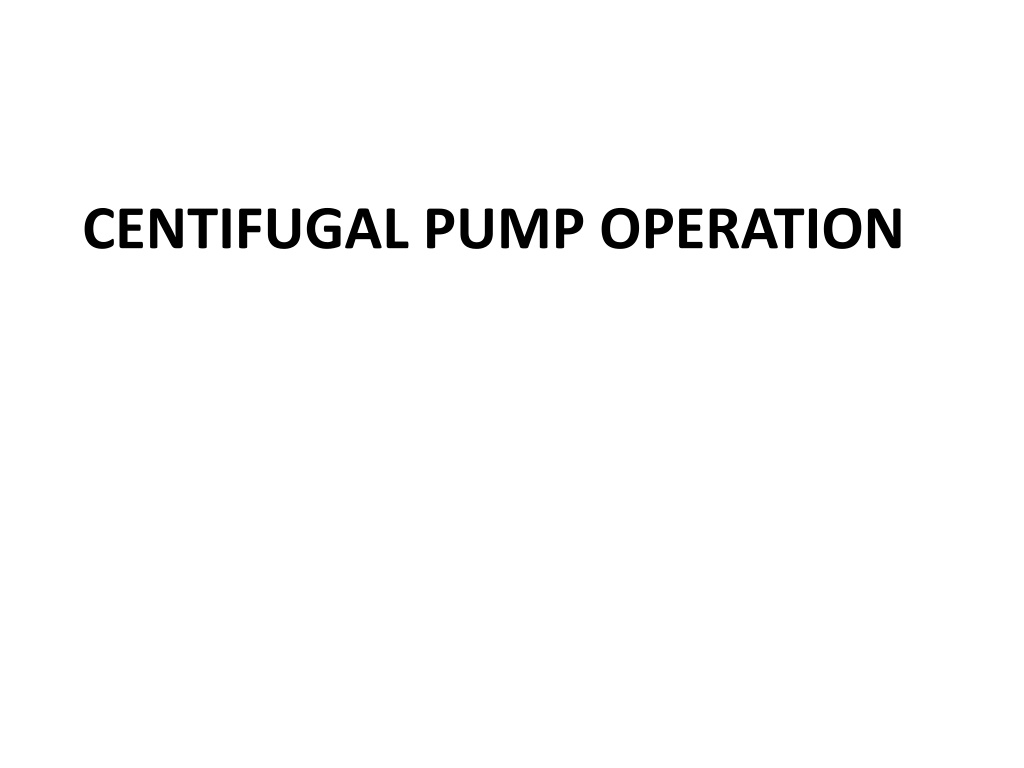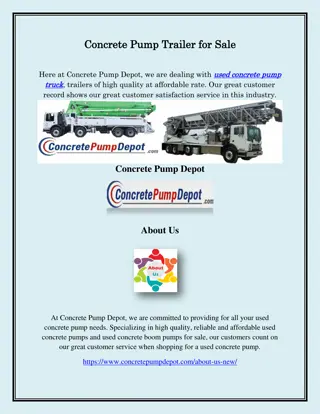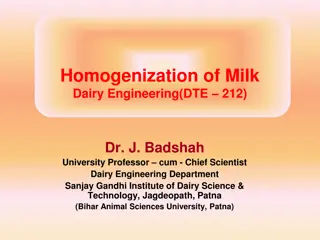Understanding Centrifugal Pump Operation and Cavitation Effects
This comprehensive guide covers the operation of centrifugal pumps, including important terminologies like static suction lift and discharge head, dynamic head components such as velocity and pressure head, and the impacts of cavitation on pump performance. Learn about the definition of cavitation, its effects on pump performance, and steps to prevent and mitigate cavitation issues. Detailed images illustrate pressure profiles and cavitation processes within pumps.
Download Presentation

Please find below an Image/Link to download the presentation.
The content on the website is provided AS IS for your information and personal use only. It may not be sold, licensed, or shared on other websites without obtaining consent from the author. Download presentation by click this link. If you encounter any issues during the download, it is possible that the publisher has removed the file from their server.
E N D
Presentation Transcript
Some Important Terminologies Static Suction Lift The distance measured vertically the intake of the pump or the pump is placed above the surface of the liquid in the suction tank. Static Suction Head The distance measured vertically the pump is placed below the surface of the liquid in the suction tank. Static Discharge Head The distance measured vertically the pump is placed below the surface of the liquid in the discharge tank. Total Static Head The vertical distance from the surface of the liquid in the suction tank to the surface of the liquid in the discharge tank. TSH = SSL + SDH TSH = SDH - SSH 1. 2. 3. 4.
5. Velocity Head The energy required to put the liquid in motion. 6. Pressure Head The energy required to impart additional pressure on the liquid to overcome the system pressure. 7. Friction Head The amount of energy required to overcome resistance in the pipes, valves and fittings. 8. Total Dynamic Head The sum of velocity, pressure and friction head. In the suction line it is called DSH In the discharge line it is called DDH 9. Total Head The total energy required to move the fluid from the suction to the discharge point. It is the sum of static and dynamic head.
CENTRIFUGAL PUMP OPERATION Cavitation Definition of cavitation Effect of cavitation on pump performance Indication that a centrifugal pump may be cavitating Steps that can be taken to stop pump cavitation How to avoid pump cavitation
Definition of cavitation The process of the formation and subsequent collapse of vapor bubbles in a pump is called cavitation.
Effect of cavitation on pump performance Three effects of pump cavitation are: Degraded pump performance resulting in a fluctuating flow rate and discharge pressure Excessive pump vibration Destructive to pump internal components (damage to pump impeller, bearings, wearing rings, and seals)
The shock of the imploding bubbles on the surface of the vane produces a gradual erosion and pitting which damages the impeller. Cavitation damage on an impeller
Indication that a centrifugal pump may be cavitating There are three indications that a centrifugal pump is cavitating. Noise Fluctuating discharge pressure and flow Fluctuating pump motor current
Steps that can be taken to stop pump cavitation Steps that can be taken to stop pump cavitation include: Increase the pressure at the suction of the pump. Reduce the temperature of the liquid being pumped. Reduce head losses in the pump suction piping. Reduce the flow rate through the pump.(reduce NPSHR) Reduce the speed of the pump impeller. (reduce NPSHR)
How to avoid pump cavitation To avoid cavitation in centrifugal pumps, the pressure of the fluid at all points within the pump must remain above saturation pressure. This can be achieved if: The net positive suction head available must be greater than the net positive suction head required. NPSHA> NPSHR
If the head losses in the pump suction piping can be reduced, the NPSHAwill be increased. Various methods for reducing head losses include increasing the pipe diameter, reducing the number of elbows, valves, and fittings in the pipe, and decreasing the length of the pipe.
Calculation of the net positive suction head available NPSHA
Gas Binding (in systems containing dissolved gases) Gas binding of a centrifugal pump is a condition where the pump casing is filled with gases or vapors to the point where the impeller is no longer able to contact enough fluid to function correctly. The impeller spins in the gas bubble, but is unable to force liquid through the pump. Effect of gas binding This can lead to cooling problems for the pump's packing and bearings.
To avoid gas binding Centrifugal pumps are designed so that their pump casings are completely filled with liquid during pump operation. Pumps in systems containing dissolved gases that are not designed to be self-venting should be periodically vented manually to ensure that gases do not build up in the pump casing.
Pump Priming Definition: Filling the pump casing and the suction line with the liquid being pumped. Methods of Priming 1- If the pump is above the source of supply close the discharge valve and open the suction valve. Open the air vent valves to allow the air in the pump casing to escape. When water flows from the vents, they can be closed and the pump is then in primed conditions and ready for starting
Fig. a The priming water comes from an external source. The discharge valve is closed and the external supply valve is opened as are the vent valves. The water flows into the pump and into the suction line where it is prevented from escaping by the foot valve. The water fills the suction line and then the pump casing. When water flows from the vent valves, they and the external supply valve are closed and the pump is ready for starting.
Fig. b The pump is primed by water which is supplied from the pump discharge line. The discharge valve is closed and the priming valve and the air vents are opened. Water from the discharge line fills the pump casing and the suction line. When water flows from the vents, the vent valves and the priming valve are closed and the pump is ready for starting.
A separate hand operated priming pump (vacuum pump) is used. The main pump discharge valve is closed and priming pump valve is opened. The priming pump is operated and it exhausts air from the main pump casing and suction line causing water to fill them. When water flows from the priming pump discharge, then the priming pump is shut and the main pump is ready for starting.
Centrifugal Pump Characteristic Curves A vendor manual for a specific pump usually contains a curve of pump flow rate versus pump head called a pump characteristic curve. After a pump is installed in a system, it is usually tested to ensure that the flow rate and head of the pump are within the required specifications.
Shutoff head is the maximum head that can be developed by a centrifugal pump operating at a set speed. Pump runout is the maximum flow that can be developed by a centrifugal pump without damaging the pump. Centrifugal pumps must be designed and operated to be protected from the conditions of pump runout or operating at shutoff head.
Pump performance curve Pump operating point Head System curve Static head Flow
Centrifugal Pump Protection Centrifugal pumps must be protected from running dead head (shutoff conditions) and runout. One method for protecting the pump from running dead-headed is to provide a recirculation line from the pump discharge line upstream of the discharge valve, back to the pump's supply source. Centrifugal pumps must also be protected from runout. Runout can lead to cavitation. One method for ensuring that there is always adequate flow resistance at the pump discharge to prevent excessive flow through the pump is to place an orifice or a throttle valve immediately downstream of the pump discharge.























